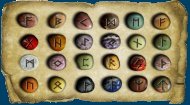|
Once you have understood the meanings of the cards, the next step is to learn how to carry out a tarot card reading. The process of selecting a small number of cards from the entire tarot deck of seventy-eight, and setting them out in a pattern to be interpreted, is called laying out a spread. There are many different kinds of spreads. Above, in a our free daily tarot reading, is the classic three card spread explaoring the past, present and future. However a more detailed tarot card reading can be obtained from one of the oldest and most popular - The Celtic Cross Tarot spread which we will explain here.
The tarot card reader should shuffle the cards gently then spreads the 78 tarot cards out in a fan shape on a table, faced down. The seeker is then asked to select 10 cards, still faced down, from the presented tarot deck. The first card selected is placed on the centre of the table, the second to its right, the third, underneath the first card, the fourth placed on the first card's left, the fifth above the first card to resemble a cross. The remaining cards are then stacked horizontally to the right of the cross, with the tenth tarot card at the top of the stack. The position of the cards then has the following symbolism:
- Position 1: This card represents the seekers current position.
- Position 2: This is the Crossing card, not only also representing the current
situation, but also representing conflict within that situation.
- Position 3: This card represents what is on the surface and immediately
apparent in the seekers life.
- Position 4: This card represents what is at the root of the problem/current
situation.
- Position 5: This card represents influences passing out of the seeker's life.
- Position 6: This card represents incoming influences.
- Position 7: This card builds upon position one; the situation the seeker will
find themselves in in the immediate future.
- Position 8: This card represents how others - family and friends - view the
- seeker's situation.
- Position 9: This card represents the seeker's inner hopes and fears.
- Position 10: This card represents the final outcome to the presenting problem/
current situation.
|




